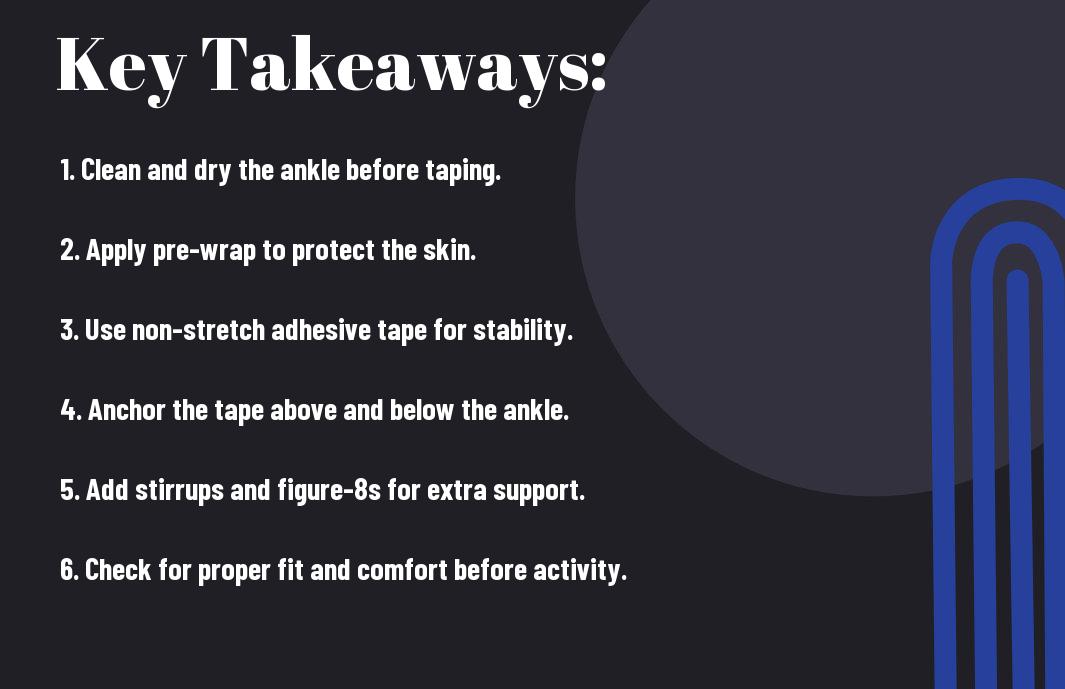Periarticular sprains are a common occurrence in sports, especially in activities that involve a lot of running and jumping. One way to prevent these kinds of injuries is to properly tape your ankles before engaging in any physical activity. In this post, I will walk you through the steps of properly athletic taping your ankle to provide support and stability, reducing the risk of sprains and other injuries. I will also cover the key techniques that will ensure you get the most out of your athletic tape and keep your ankles safe and secure during your performance. With the right knowledge and tools, you can be better prepared to keep your ankles safe while pursuing your athletic passions.
Key Takeaways:
- Proper Technique: Athletic taping an ankle requires following proper techniques to ensure maximum injury prevention and support.
- Preventative Measure: Taping an ankle before engaging in sports can help prevent sprains and other related injuries.
- Stability and Support: Athletic taping provides stability and support to the ankle joint, reducing the risk of twisting or rolling the ankle during physical activity.
- Professional Guidance: It is important to seek guidance from a trained professional to learn proper taping techniques and ensure it is done correctly.
- Regular Maintenance: Re-taping the ankle regularly and checking for proper fit and support is crucial for injury prevention and maintaining stability.
Preparing for Taping
While preparing to tape your ankle, there are a few important steps to take to ensure the taping is effective and provides the support needed for your specific athletic activity. Proper taping starts with choosing the right athletic tape
Choosing the Right Athletic Tape
When choosing athletic tape for taping your ankle, it is important to select a tape that provides good support and stability. Look for a tape that is elastic and provides moderate compression to help reduce swelling and support the ankle joint during movement. Additionally, consider the type of sports activity you will be engaging in, as this can also help determine the type of tape that will best meet your needs.
Assessing the Ankle for Taping
Before applying athletic tape to your ankle, it is essential to assess your ankle for any signs of injury or weakness. Look for swelling, tenderness, or bruising that may indicate an existing injury. It is also important to assess your range of motion and any areas of instability in the ankle. Assessing your ankle thoroughly will help determine the areas that need the most support and ensure that you apply the tape properly to provide the necessary reinforcement.
Athletic Taping Techniques
Any athlete knows the importance of properly taping their ankles to prevent injury. It provides stability and support, especially during high-intensity sports activities. Below, I will outline the essential athletic taping techniques that every athlete should know to protect their ankles.
Applying the Anchor Strips
When it comes to athletic taping, applying the anchor strips is the first step in securing the tape in place. Start by wrapping a strip of athletic tape around your ankle, just above the ankle bone. It should be snug, but not too tight, as you want to allow for proper blood circulation. The anchor strips provide a base for the rest of the taping process, ensuring that the tape stays in place during vigorous physical activity.
Creating Supportive Stirrups
Creating supportive stirrups is crucial for providing the additional support needed to prevent ankle injuries. To do this, I anchor the tape on the inside of the foot, run it under the arch, and wrap it around the outside of the foot. This creates a stirrup-like support structure that minimizes side-to-side rolling of the ankle. This technique is especially beneficial for athletes who are prone to ankle injuries, as it provides maximum stability and support to the ankle joint.
Taping for Specific Sports
Not all sports require the same type of ankle taping. The specific demands of each sport can affect the way you tape your ankle to provide the best support and prevent injury. Here are some techniques for taping your ankle according to the requirements of different sports.
Techniques for Basketball Players
As a basketball player, you require agility, speed, and quick changes in direction using your feet. This puts a lot of stress on your ankles, making them prone to injury. When taping your ankle for basketball, it’s essential to use a strong, rigid tape to provide enough support. Focus on reinforcing the ligaments on the outside of your ankle and provide extra stability for sudden lateral movements. I recommend using the figure-eight taping technique to secure your ankle and prevent injuries while playing basketball.
Taping for Soccer Players
Playing soccer involves a lot of running, cutting, and sudden stops, making ankle taping crucial for injury prevention. When taping your ankle for soccer, make sure to use a tape that allows for some flexibility while providing adequate support. Focus on taping the ankle in a way that offers protection against awkward landings and sudden directional changes. I suggest using the heel lock technique to stabilize your ankle and provide the necessary support for the demands of soccer.


How to Athletic Tape an Ankle – Techniques for Sports Injury Prevention
Considering all points, I hope this guide on how to athletic tape an ankle has been helpful in providing you with the knowledge and techniques needed to prevent sports injuries. By following these steps and practicing regularly, you can ensure that your ankles are properly supported and protected during physical activity. For further detailed instructions, you can refer to the article “How to Tape an Ankle Like an Athletic Trainer: 12 Steps” on wikihow.com. Stay safe and stay active!
FAQ
Q: Why is it important to tape an ankle for sports injury prevention?
A: Taping an ankle provides stability and support to the joint, reducing the risk of sprains and other sports-related injuries.
Q: What materials do I need to athletic tape an ankle?
A: You will need athletic tape, pre-wrap, and scissors. Additionally, it may be helpful to have a spray adhesive or skin adhesive to help the tape adhere to the skin.
Q: How tight should the tape be wrapped around the ankle?
A: The tape should be wrapped snugly around the ankle, providing support without cutting off circulation. It’s important to check for any signs of numbness or tingling, which could indicate that the tape is too tight.
Q: How long can I leave athletic tape on my ankle?
A: Athletic tape should not be left on for more than 48 hours. It is important to remove the tape to allow the skin to breathe and prevent any potential irritation or damage.
Q: Can athletic taping be used as a substitute for rehabilitation and strengthening exercises?
A: No, athletic taping should be used as a complement to proper rehabilitation and strengthening exercises. It is not a substitute for addressing the underlying causes of ankle instability or weakness. It is important to consult with a healthcare professional for a comprehensive treatment plan.









Leave a comment